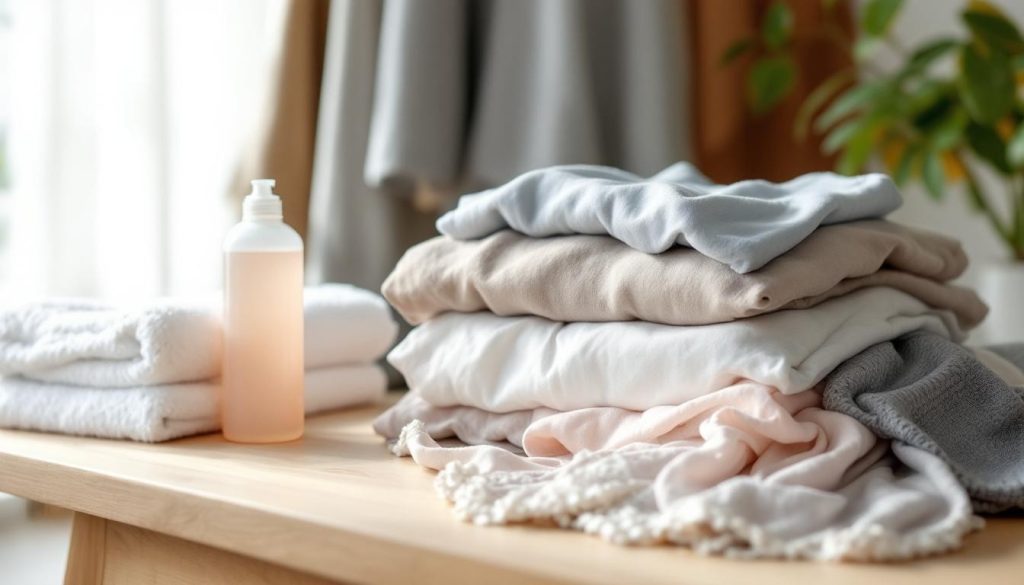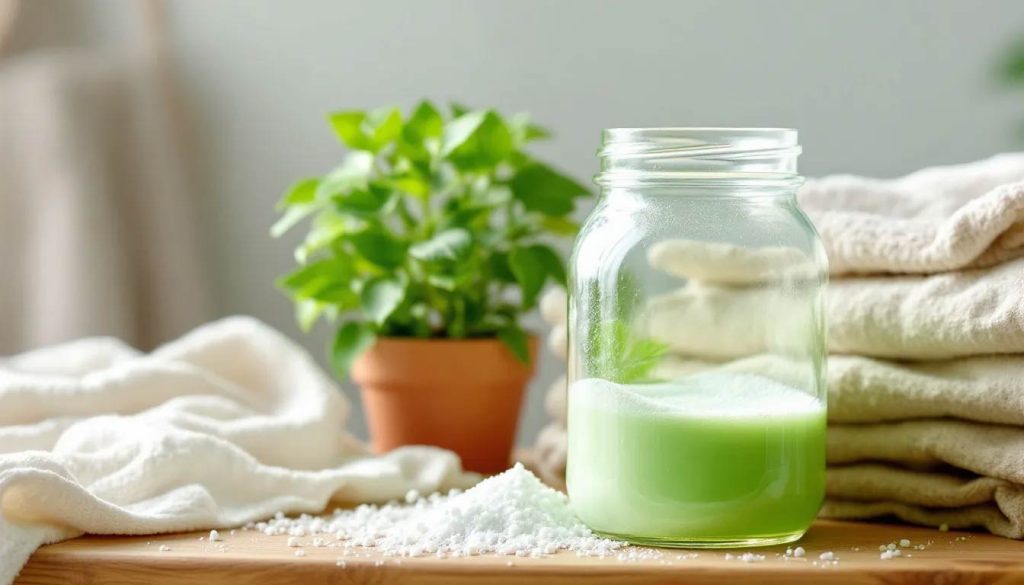At Oasis Laundry, we know that caring for delicate garments can be a challenge. From silk blouses to lace lingerie, these special pieces require extra attention to maintain their beauty and longevity.
In this guide, we’ll share our expertise on specialty cleaning techniques for your most precious items. You’ll learn how to wash, dry, and store delicate fabrics to keep them looking their best for years to come.
Understanding Delicate Fabrics
Types of Delicate Fabrics
Delicate fabrics require special care to maintain their quality and extend their lifespan. These materials include silk, lace, cashmere, and other fine textiles. Each type has unique characteristics and care requirements.
Silk: The Queen of Fabrics
Silk stands out for its smooth texture and lustrous appearance. However, it’s highly susceptible to water stains and can lose its sheen if washed incorrectly. Silk garments often experience color bleeding, shrinkage, and fiber weakening when exposed to harsh detergents or high temperatures.
Lace: Intricate and Fragile
Lace garments are delicate due to their open-weave structure. They can easily snag, tear, or lose shape if not handled with care. Lace also tends to yellow over time, especially when exposed to harsh chemicals or improper storage conditions.
Cashmere: Luxury Wool
Cashmere, a type of fine wool, is prized for its softness but can be challenging to maintain. It’s susceptible to pilling, shrinkage, and moth damage. Improper washing can cause cashmere to lose its shape and softness, significantly reducing its value and comfort.
The Importance of Proper Care
Proper care for these delicate fabrics is essential. Following care instructions meticulously is crucial for maintaining the quality of your garments. Care labels may include terms such as “ironed at a hot setting,” “can be bleached with all commercially available bleaches,” and “can be drycleaned.”
Using a specialized detergent can make a significant difference. These detergents clean effectively while remaining gentle on delicate fibers. They help preserve the fabric’s integrity, color, and texture.
When it comes to washing frequency, less is often more for delicate items. Overwashing can lead to premature wear and tear. Instead, spot cleaning and airing out garments between wears can help extend their life.
Advanced cleaning techniques tailored to each fabric type ensure that delicate garments receive the care they need to stay beautiful and last longer. Investing time in proper care now can save money and preserve favorite pieces for years to come.
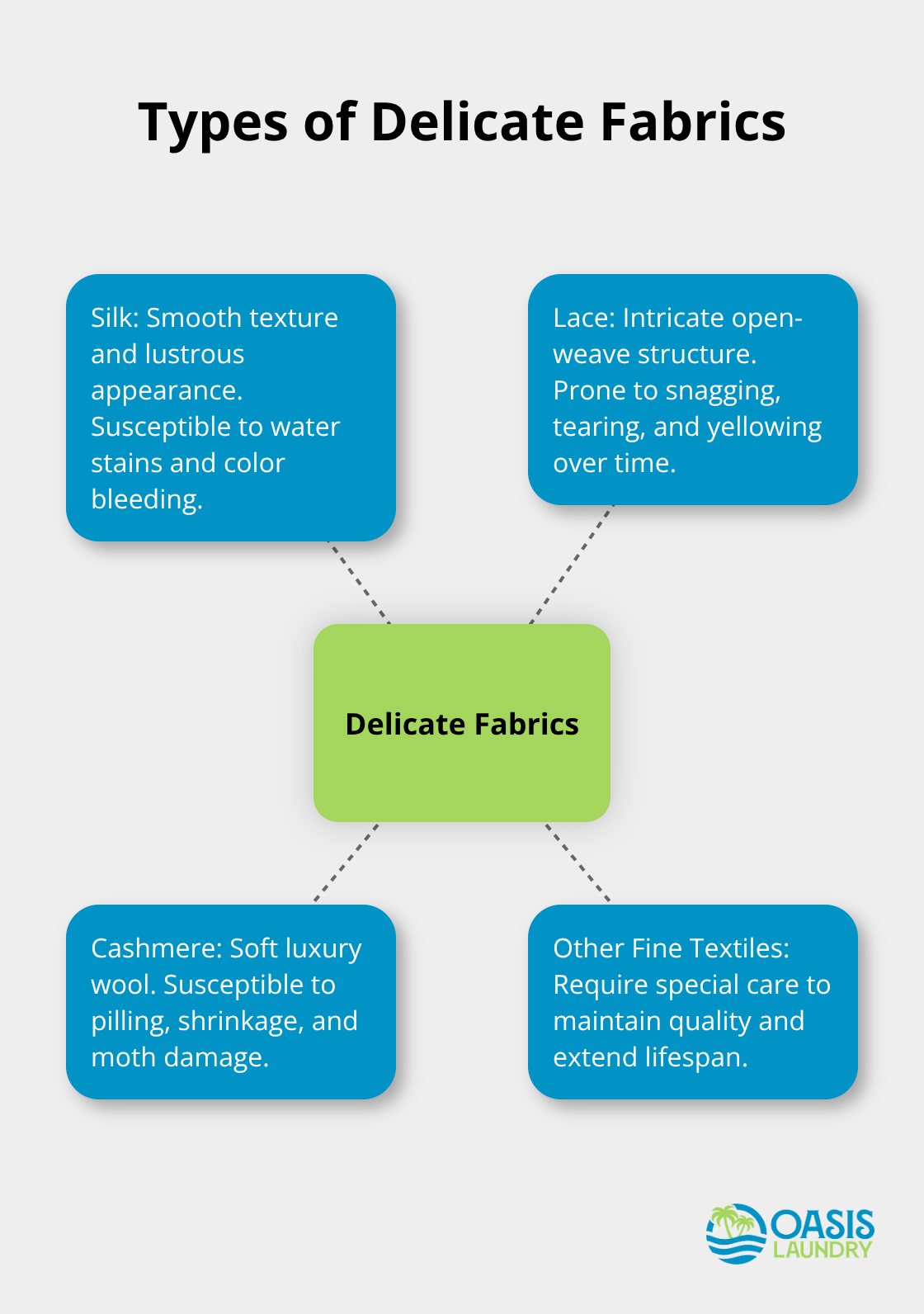
As we move forward, let’s explore the specific washing techniques that will help you maintain your delicate garments in pristine condition.
Mastering Delicate Garment Care
Hand Washing: The Gold Standard
Hand washing stands as the safest method for delicate fabrics. The best way to hand wash clothes is to submerge the item in water mixed with detergent. Use your hands to gently wash garments, swishing the water by hand. Rinse thoroughly with cool water until you remove all soap. Press out excess water without squeezing.
Machine Washing: A Cautious Approach
If the care label permits, machine washing suits some delicates. Use a mesh laundry bag to protect items from snagging. Select the delicate cycle and cold water setting. Don’t overload the machine, as this can damage fragile items.
The Importance of Detergent Selection
Choose a mild, pH-neutral detergent specifically formulated for delicates. Avoid harsh chemicals and enzymes that break down fibers. Liquid detergents (which dissolve more easily in water) reduce the risk of residue on fabrics.
Temperature and Cycle Considerations
Cold water proves generally safest for delicate fabrics. It prevents shrinkage and color bleeding. For machine washing, always use the gentlest cycle available. Short wash times and low spin speeds minimize wear and tear on delicate fibers.
Fabric-Specific Care Tips
Silk requires extra attention. Use a detergent designed for silk and never wring or twist the fabric. For cashmere, wash by hand in lukewarm water and reshape while damp. Wash lace separately to prevent snagging on other items.
Professional cleaning offers a reliable option for challenging items. Experts (like those at Oasis Laundry) specialize in handling even the most delicate garments with precision and care.
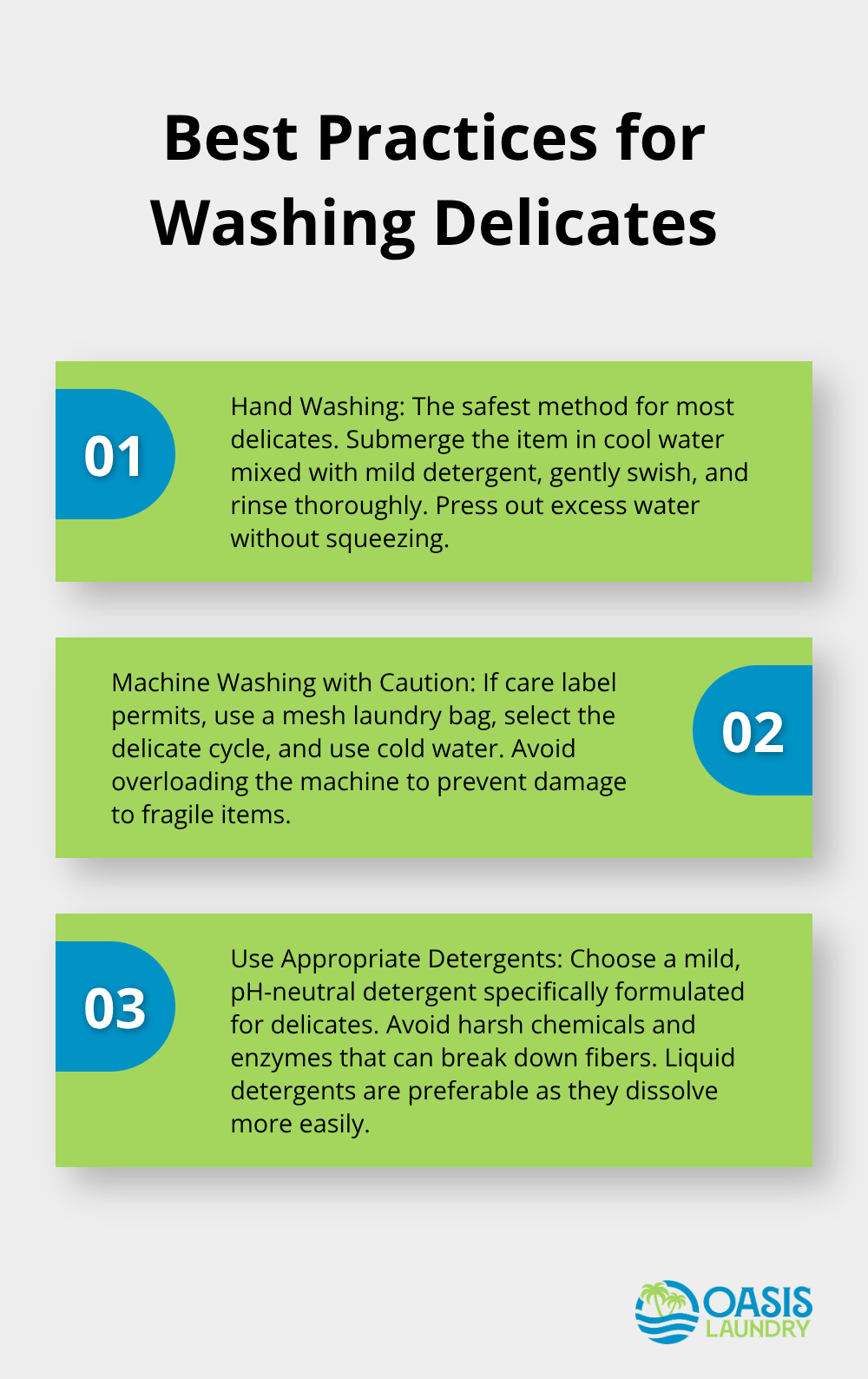
Now that you’ve mastered the art of washing delicates, let’s explore the best methods to dry and store these precious items to maintain their quality and longevity.
How to Dry and Store Delicate Garments
Air Drying: The Safest Method
Air drying is best for most delicate fabrics, especially items prone to changing shape, like knitted fabrics. Place the garment flat on a clean, dry towel. Gently reshape it to its original form. For items prone to stretching (such as sweaters), use a mesh drying rack. This allows air circulation without distorting the shape.
Using a Dryer with Caution
Always check the care label before using a dryer. Some delicates tolerate low heat settings. Select the lowest heat possible and remove items while they’re still slightly damp. This prevents over-drying, which can cause shrinkage and damage fibers. Use a delicates bag to protect items from snagging or tangling with other clothes.
Folding and Hanging Techniques
Store your delicates with care after drying. Fold sweaters and knits instead of hanging them to prevent stretching. Use acid-free tissue paper between folds to prevent creasing. When you need to hang items (like silk blouses), choose padded hangers to maintain their shape.
Optimal Storage Solutions
Keep delicate garments in a cool, dry place away from direct sunlight. This prevents fading and fabric degradation. Use cedar blocks or lavender sachets to repel moths naturally. For long-term storage, opt for breathable garment bags made of cotton or muslin. Avoid plastic bags, which can trap moisture and lead to mildew.
Seasonal Care and Rotation
Rotate your delicate items seasonally to prevent excessive wear in specific areas. Clean and dry garments completely before storing them for extended periods. Inspect items for loose threads or minor repairs before storage. This prevents small issues from becoming major problems later.
Professional cleaning services (like those offered by Oasis Laundry) benefit delicate items before long-term storage. Expert handling of fine fabrics ensures proper cleaning and preparation, which maximizes garment lifespan and maintains quality.
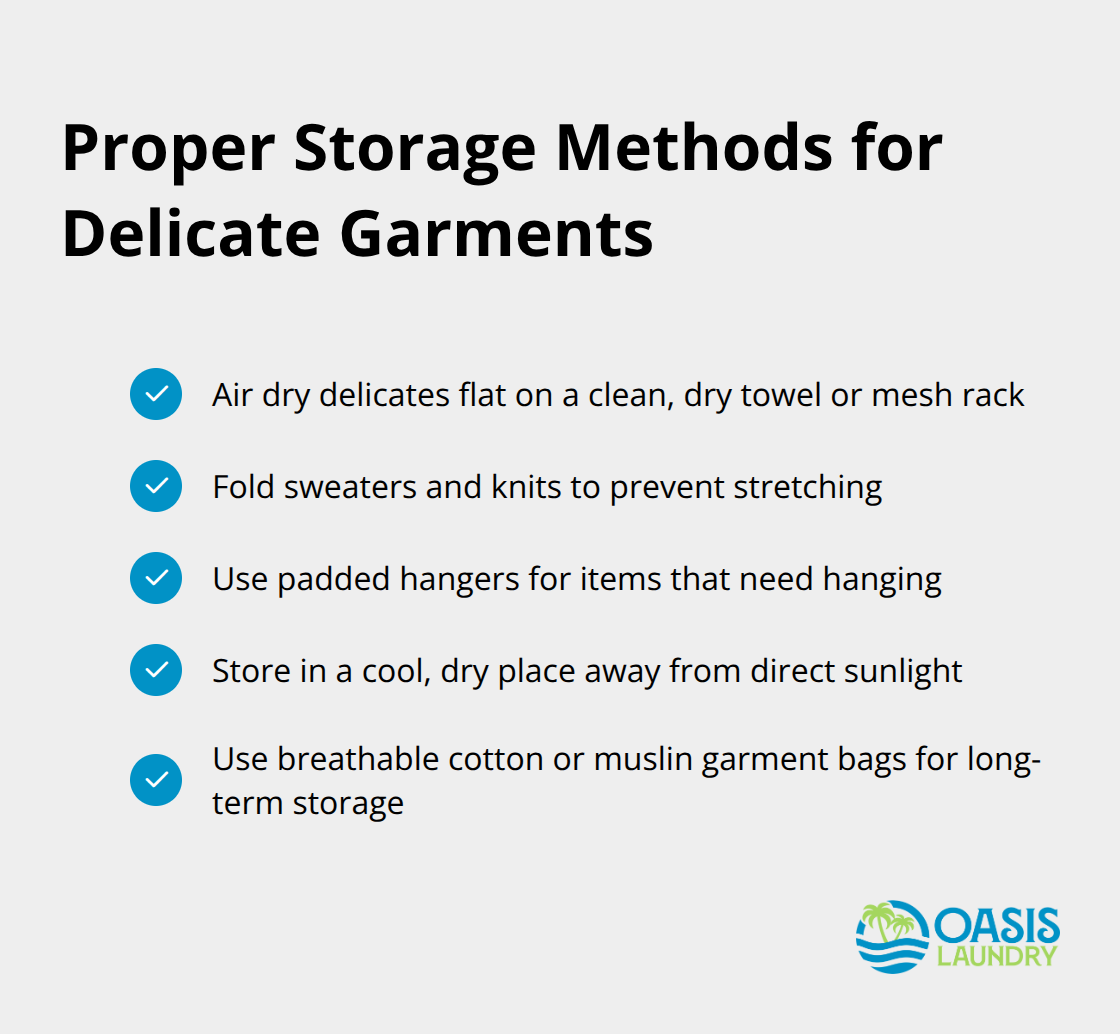
Final Thoughts
Proper care for delicate garments preserves their beauty and extends their lifespan. You should hand wash most delicates, but careful machine washing can work for some items. Cold water and mild detergents protect fragile fibers best.
Air drying on a flat surface or mesh rack prevents stretching and distortion. You should fold knits and use padded hangers for items that need hanging. Store your precious garments in a cool, dry place away from direct sunlight to prevent fading.
Specialty cleaning services provide expert care for challenging items. We at Oasis Laundry offer tailored solutions for even the most delicate garments (including textile restoration). Our eco-friendly cleaning methods ensure your cherished items receive the best possible care.


